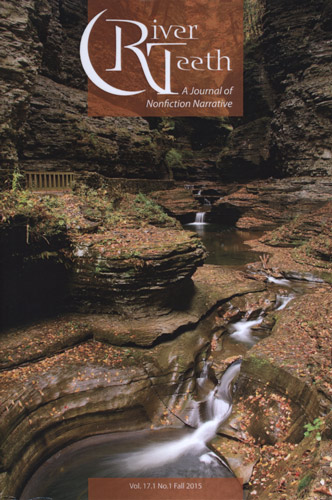River Teeth – Fall 2015
“My mother taught me that the dead are among us—look closely and you’ll begin to notice them everywhere . . . The world is full of codes and keys, maps and legends. You wake up one morning, and ask yourself, How is it all connected? The question haunts you for the rest of your life.” (Karen Dietrich’s “Air and Water”). Here lies one of my favorite passages from this issue of River Teeth, a collection of creative nonfiction. And how is this writing all connected? It is, after all, deemed worthy to all fall beneath the same covers. I think it’s the human experience, and the raw need to make an understanding of life’s experiences and mysteries.
“My mother taught me that the dead are among us—look closely and you’ll begin to notice them everywhere . . . The world is full of codes and keys, maps and legends. You wake up one morning, and ask yourself, How is it all connected? The question haunts you for the rest of your life.” (Karen Dietrich’s “Air and Water”). Here lies one of my favorite passages from this issue of River Teeth, a collection of creative nonfiction. And how is this writing all connected? It is, after all, deemed worthy to all fall beneath the same covers. I think it’s the human experience, and the raw need to make an understanding of life’s experiences and mysteries.
One popular human mystery we often want to make sense of is our dreams. The collection opens with Joe Wilkins’s “As a Boy I Dreamed Often of a Tiger,” a creative piece drawing together short paragraph-long vignettes surrounding the theme of tigers. When he was young, Wilkins used to fear a tiger he would dream coming from his parents’ bedroom and wonders if it was his “child’s way of reckoning the cancer even then gnawing at [his] strong father’s bones.” And now that his own daughter has a bad dream of a tiger, what does that mean for him? Each small vignette holds its own weight, and readers can rely heavily on the details to discover insight.
In Stephen Benz’s essay “A Grave on the High Plains,” Benz ponders on Unthank’s grave and spells out the disillusionment surrounding the old ideal of going west to “see the elephant.” Unthank was one of those pioneers who did not survive long enough to see his Western American dream, new diseases taking him out before he could get there. The essay is perfectly balanced between historical facts, personal reflection, and analysis. Benz concludes with a line I think we have all been able to identify with: “all of us rushing on, chasing the dream, heedless of the landscape we crossed and oblivious to the elephant looming in the path.”
And as we head out and strive toward those dreams, we are hit with the reality that “there is nothing that we can truly control here.” Kerry Folan explores this idea in her story “Animals of the Suburbs,” in which she is living with a family whose eldest daughter is obsessed with a dead fox they find in the woods. The piece is deep and personal, as well as a bit eerie at times, but definitely worth the read.
The standout for me is Jill Christman’s “Going Back to Plum Island,” which is as compelling as it is honest. It is cavernous and raw, admitting that, though we may have gone through trauma and dealt with it—moved on, in order to fully heal, we must “go right through the middle. We have to know what’s in the dark places. . . . There’s no other way through.” The piece is beautifully sculpted because the reader knows there is hurt associated with a “Ted” from Christman’s past, but that is not the scene that is painted. It is not important as readers that we see exactly what happened; the story is in “going back” and facing the fear itself. It is incredibly relatable, and I have ticked off several passages to go back and read for my own personal benefit.
This issue of River Teeth gets into those burning issues and desires within all of us—allowing the reader to connect with the writing and the writer. So how is it all connected? We may never know, but reading this collection makes you realize that we all are.
[www.riverteethjournal.com]





